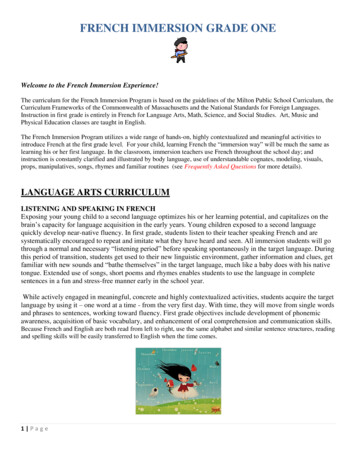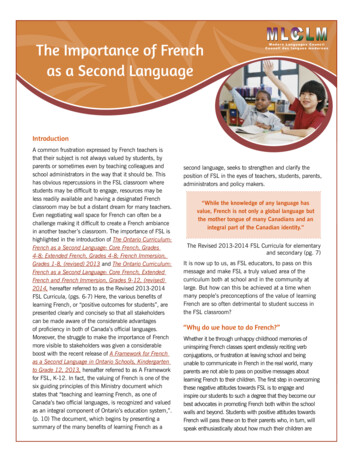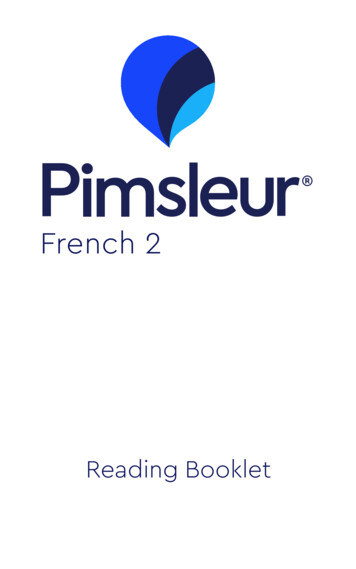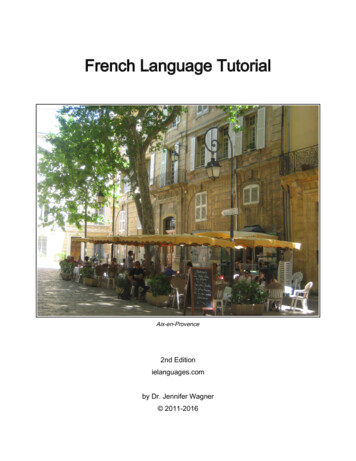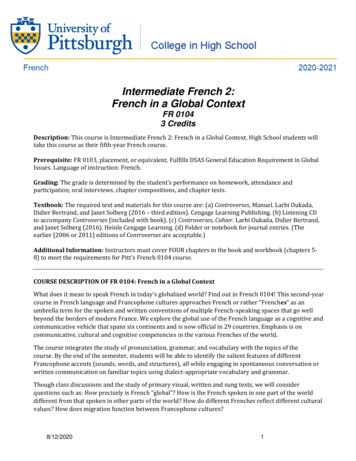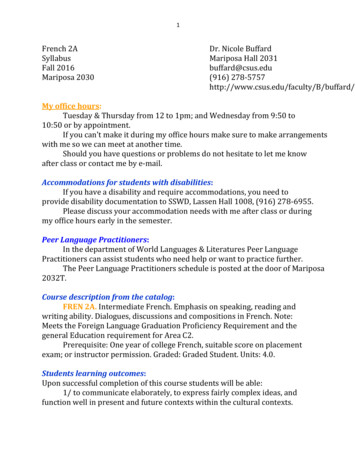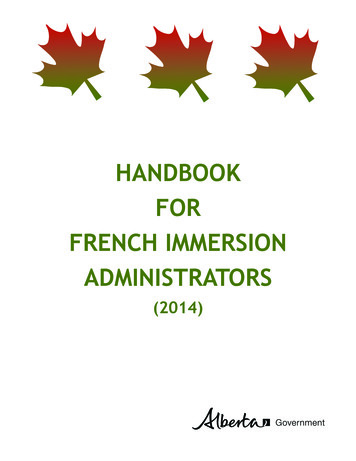
Transcription
HANDBOOKFORFRENCH IMMERSIONADMINISTRATORS(2014)
ISBN 978-1-4601-1844-3 (PDF)ISBN 978-1-4601-1845-0 (HTML)Several Web sites are listed in this resource. These sites are listed as a service only to identifypotentially useful ideas for teaching and learning. Alberta Education is not responsible for maintainingthese external sites, nor does the listing of these sites constitute or imply endorsement of their content.The Crown and its agents, employees or contractors will not be liable for any direct or indirectdamages arising from the use of any of these sites. The responsibility to evaluate these sites rests withthe user. Note: All Web site addresses were confirmed as accurate at the time of publication but aresubject to change.Copyright 2014, the Crown in Right of Alberta, as represented by the Minister of Education.Alberta Education, French Language Education Services, 9th Floor, 44 Capital Boulevard,10044 - 108 Street NW, Edmonton, Alberta, Canada, T5J 5E6.Every effort has been made to provide proper acknowledgement of original sources. If cases areidentified where this has not been done, please notify Alberta Education so appropriate correctiveaction can be taken.Permission is given by the copyright owner to reproduce this resource for educational purposes andon a nonprofit basis, with the exception of materials cited for which Alberta Education does not owncopyright.Permission is also granted for sharing the electronic files via network capabilities at the school orjurisdiction level.
TABLE OF CONTENTSChapter 1: The Immersion Approach—Principles and PracticeA. IntroductionB. Program GoalsC. Key CharacteristicsD. How French Immersion WorksIntegration of Language and ContentLearning Two Languages: SimilaritiesLearning Two Languages: DifferencesTransfers and InterferenceE. Immersion PedagogyInterests and Needs of LearnersLinguistically Rich Learning EnvironmentVariety of Authentic Learning SituationsVibrant School cultureF. Types of SchoolsImmersion CentreDual-track or Multi-track SchoolG. French Immersion Delivery ModelsEarly French immersionLate ImmersionComparison—Early and Late ImmersionH. Research FindingsI. Myths and FactsJ. Historical Overview of French Immersion1960s1970s1980-90s2010K. French Language Instruction in ReferencesChapter 2: Conditions for Educational SuccessA. IntroductionB. ProgrammingProgram CharacteristicsAmount of TimeiiiHandbook for French Immersion AdministratorsAlberta Education, Canada, 2014Table of Contents
C. TeachingTeaching StrategiesTeacher CharacteristicsD. French InstructionListening and Speaking Skillsi. The teacherii. The studentReading and Writing Skillsi. Reading skillsii. Writing skillsE. English InstructionF. When Should English Language Arts Be Introduced?G. Who Teaches the English Portion of Time?H. Teaching the Content SubjectsI.KindergartenJ. French Immersion at the Secondary LevelK. The Importance of CultureL. Language Instruction Across the DisciplinesM. LeadershipN. StabilityO. Professional DevelopmentP. ResourcesQ. Support ServicesReferencesChapter 3: Providing Provincial Leadership for French ImmersionA. IntroductionB. Language Education in AlbertaC. School AdministrationGuide to EducationTime Requirements Elementary SecondaryD. Program ResourcesKindergartenGrades 1 to 12E. Provincial FundingivHandbook for French Immersion AdministratorsAlberta Education, Canada, 2014Table of Contents
F. Federal FundingProgram FundingTeacher Bursary ProgramStudents: Language Learning ProgramStudents: Language Development Exchange ProgramLanguage AssistantsProgram Development for School JurisdictionsG. Provincial AssessmentH. French Immersion Students’ ResultsI.Language of Diplomas and TranscriptsJ. French Language Education ServicesReferencesChapter 4: Providing Jurisdictional Leadership for French ImmersionA. IntroductionB. Roles and ResponsibilitiesTrusteesSuperintendents and Senior Administratorsi. Programii. Program deliveryiii. Fundingiv. Networkingv. Leadershipvi. Program promotionvii. Students with special needsC. Policy MattersThe Value of Second Language Learning in EducationAccess and EquityD. Long-range PlanningFunding and AccountabilityStability and GrowthStaffingProfessional DevelopmentSupport ServicesQuality and AssessmentReferencesChapter 5: Providing School Leadership for French ImmersionA. IntroductionB. Addressing Program Needs in Dual-track SchoolsCondition for SuccessTrue PartnershipC. Creating a School CultureFrench: The Language of CommunicationCultural EventsCommunity SupportsHandbook for French Immersion AdministratorsAlberta Education, Canada, 2014vTable of Contents
Good Working RelationsA Program for all StudentsD. Staffing: Setting the Stage for SuccessTeacher Interviewsi. Educational philosophyii. Second-language pedagogyiii. Second-language methodologyiv. French culturev. Student evaluationvi. Language skillsvii. Language proficiency goalsviii. English language skillsix. Area of expertisex. Teaching challengesxi. Potential contributionxii. Career plansE. Supporting Newly Hired StaffF. Supervising and Evaluating StaffG. Professional Development NeedsFrench Language SkillsTeaching StrategiesNetworkingProfessional JournalsH. Organizing for InstructionI.Establishing and Maintaining a LibraryJ. Responsibilities of Staff and School CouncilsTeaching StaffResource and Support StaffSchool CouncilsReferencesChapter 6: Supporting and Working with ParentsA. IntroductionB. Parents as PartnersC. What All Parents Need to Support Their Child’s EducationKnowledgeSkillsAttitudesD. What French Immersion Parents Need to Support Their Child’s EducationKnowledgeSkillsAttitudesE. Benefits of Involving ParentsBenefits for StudentsBenefits for TeachersBenefits for ParentsBenefits for AdministratorsHandbook for French Immersion AdministratorsAlberta Education, Canada, 2014viTable of Contents
F. Tools and StrategiesToolsStrategiesG. Strategies—Immersion Parents’ NeedsUnderstanding the ProgramUnderstanding the Curriculum and Teaching StrategiesHow to Help with HomeworkHelping at SchoolUnderstanding Provincial AssessmentsEffective Home-School CommunicationH. Resources for ParentsReferencesChapter 7: Recruitment and Retention of French Immersion StudentsA. IntroductionB. Factors that Influence RecruitmentSuccessful Recruitment StrategiesNegative Recruitment Factorsi. Practical factorsii. Program factorsiii. Student factorsiv. Parent factorsPositive Recruitment Factorsi. Program factorsii. Parent factorsC. Factors that Influence RetentionElementary Leveli. Student factorsii. Parent factorsiii. Program factorsSecondary Leveli. Student factorsii. Parent factorsiii. Program factorsD. Marketing: The ProcessComponents of Marketingi. Productii. Priceiii. Locationiv. PromotionMessages Promoting French ImmersionDid You Know?E. Long-term ViabilityMarketing Plan and Annual PromotionTarget AudienceTeamworkStrategies, Activities and MaterialsHandbook for French Immersion AdministratorsAlberta Education, Canada, 2014viiTable of Contents
F. Promotional Activities and ToolsAttract Attentioni. Promotion by a school or jurisdictionii. Promotion involving the communityiii. Promotion involving parents, students and graduatesMake A Good First Impressioni. Receptionii. Appearanceiii. Toursiv. Make timeProvide Program DetailsDevelop a Comfort Leveli. Use direct promotional materialsii. Involve the communityOrganize Parent Information EveningsInvolve the ParentsReferencesChapter 8: Inclusion of Students with Diverse Needs in French ImmersionA. IntroductionB. What is inclusion?C. Advantages of inclusion in French ImmersionD. Guiding the concerned teacherE. Can diverse learning needs be supported in a French Immersion program?F. Additional financial support for studentsG. Accountability to students in French Immersion schoolsH. Strategies to meet all needs in the French Immersion classroomI.Differentiated instruction in a French Immersion classroomJ. Decision about transferring a student to an English-only programK. Transferring to an English-only programL. ConclusionM. Recommended resourcesReferencesChapter 9: French Studies Beyond Grade 12A. Post-secondary OpportunitiesB. Alberta UniversitiesAthabasca UniversityGrant MacEwan UniversityMount Royal UniversityUniversity of Alberta—Campus Saint-JeanUniversity of Alberta—Faculty of ArtsHandbook for French Immersion AdministratorsAlberta Education, Canada, 2014viiiTable of Contents
University of CalgaryUniversity of LethbridgeC. Alberta Community CollegesD. Elsewhere in CanadaBritish ColumbiaSaskatchewanManitobaOntarioQuebecNew BrunswickNova ScotiaE. Other Post-secondary OpportunitiesChapter 10: Support Agencies and What They OfferA. Cultural Activities/OrganizationsACCENTAlliance FrançaiseCiné-Club of EdmontonCinémagineConseil de développement économique de l’AlbertaFrancaltaLa GirandoleLe Regroupement artistique francophone de l’AlbertaLa Société francophone des arts visuels de l’AlbertaL’UnithéâtreB. Newspapers and MediaLe ChinookLe FrancoRadio-Canada—AlbertaC. French BookstoresLe CarrefourLivres LacosteD. Provincial and National AssociationsAlberta School Boards Association for Languages EducationAssociation canadienne-française de l’AlbertaCanadian Association of Immersion TeachersCanadian Parents for French Background CPF and the school administratorConseil françaisFédération des parents francophones de l’AlbertaE. Government AgenciesFrancophone SecretariatOffice of the Commissioner of Official LanguagesChapter 11: Textual and Multimedia ResourcesA. Authorized Resources DatabaseB. LearnAlberta.caC. ConnectionD. 2LearnixE. Professional Development ResourcesHandbook for French Immersion AdministratorsAlberta Education, Canada, 2014Table of Contents
AppendicesAppendix A French Immersion: How It Works Uses and Misuses of Research in School Board Decision-Making: Examplesfrom French ImmersionAppendix B Re-energizing a French Immersion Program: The Fort McMurray RCSSD Story When Should English Language Arts be Introduced in the Early French Immersion ProgramAppendix C Building the Future: The Role of the TrusteeAppendix D A French Immersion School Culture: The Foundation for Success Building the Future: The Role of the School Administrator Creating English-French Immersion Harmony in Dual Track Schools: Canadian RockiesDistrict Task Force Understanding the French Immersion Teacher: Implications for Training, Hiring, Supervising,and Supporting Your French Immersion StaffAppendix E Marketing French Immersion in Alberta: A Conceptual Framework Program Promotion: Generating Interest and InvolvementxHandbook for French Immersion AdministratorsAlberta Education, Canada, 2014
THE IMMERSION APPROACH—PRINCIPLES AND PRACTICEChapter1A. IntroductionFrench immersion is a proven approach to second language learning developed in Canadain response to a desire of English-speaking parents to have their children become fluent inFrench. Two other French programs are also offered in Alberta schools: French first language(francophone) and French as a second language. French immersion is offered in Alberta as analternative program as provided in Section 21 of the School Act.French immersion began in Canada in 1965 as a well-researched experiment in St. Lambert,Quebec. The success of the program and the extensive research related to the learning ofFrench, English and subject area content quickly became known across Canada. Frenchimmersion programs were first offered in Alberta in the early 70s.In the 2009-2010 school year, 28 public school authorities and 13 separate school authorities and3 private schools in Alberta schools offered a French immersion program to 34,885 students.Student enrolment across grade levels for the 2009-2010 school year follows:Kindergarten3,839Elementary18,766Junior high7,573Senior high4,707B. Program GoalsEnglishTo enable students to achieve a level of competence in English equivalent to English programstudents within three years of beginning instruction in English, and to maintain that equivalencythrough Grade 12.FrenchTo enable students to become functionally fluent in French by the end of Grade 12, Frenchimmersion students will be able: to participate easily and willingly in conversations in French; to communicate in French for both personal and professional needs; to pursue their post-secondary education in French; to accept employment where French is the language of work.1Handbook for French Immersion AdministratorsAlberta Education, Canada, 2014Chapter 1:The Immersion Approach—Principles and Practice
Subject Area ContentTo enable students to achieve the learner outcomes in all core and complementary courses.CultureTo enable students to gain an understanding and appreciation of francophone cultures.C. Key Characteristics Designed for students whose family heritage is other than French. A second language program in which French is the language of instruction for a significantpart of the school day; several or all subjects, with the exception of English Language Arts,are taught in French. A program with two entry points: Early immersion begins in Kindergarten or Grade 1; Late immersion begins in Grade 6 or 7. All students follow the Alberta Program of Studies and are expected to achieve establishedstandards. French is acquired primarily by using it for meaningful communication within the school—that is, for instruction in subject areas. The students begin the program with little or no knowledge of French; instructionalstrategies and materials are designed with this in mind. The program begins with intensive instruction in French. Teaching of subject material is not repeated in English. In order to best achieve the program goals, early and late immersion students are expected toremain in the program until the end of Grade 12. Parents play a key role in promoting immersion programs and in supporting their childachieve the goals of the program.D. How French Immersion WorksIntegration of Language and ContentFrench immersion integrates language instruction and content area instruction. Students learnthe French language, they learn about the French language and they learn through the Frenchlanguage. Learning the language enables students to read, speak, write and listen in French. Students learn about the language when they study French as a subject. Students learn through language when they use French to solve problems, understandconcepts and create knowledge.These three notions are interwoven throughout the students’ French immersion experience.They learn the language as they are acquiring concepts in different subjects. As children learnHandbook for French Immersion AdministratorsAlberta Education, Canada, 2014Chapter 1:The Immersion Approach—Principles and Practice2
to read, they are also reading to learn. The same is true of language learning, be it one’s firstor second language. We learn a language and about the language as we use it in meaningfulcontexts. In French immersion, students are given many opportunities to use French for avariety of purposes. Finally, learning through language entails that all subject area teachersare also teachers of language. It is through language that students meet the learner outcomesidentified for various subject areas.Learning Two Languages: SimilaritiesChildren learn a second language in much the same way they learned their first language,by interacting with their environment to satisfy communication needs. At the beginning,this interaction involves approximations, risk-taking and negotiating meaning in a secureenvironment. Language is learned globally. Listening, speaking, reading and writing areinterwoven and not acquired in a linear sequential fashion.Learning Two Languages: DifferencesIf there are similarities between learning a first and second language, there are also differences.A major difference is related to motivation. The motivation to learn and use a second languageis not as strong as that of using one’s mother tongue. Students can always revert to their firstlanguage, an easy solution in the early stages of second language acquisition. This has importantimplications for immersion teachers who must endeavour to present authentic and motivatinglearning situations that will compel students to communicate in French.Transfers and InterferenceAnother challenge in addition to motivation is dealing with the interferences that arise whenlearning and using two languages. These interferences can be related to word usage, syntax orpronunciation. Immersion teachers know that such errors are a natural part of second languagelearning. They know when and how to correct them.French immersion teachers also build on the transfers and commonalities that exist betweenEnglish and French: related syntax, basic grammatical structures, many identical phonemes andmany identical or similar words. These positive effects far outweigh the interferences. LearningFrench allows students to reflect on the similarities and differences between their first languageand French, and in doing so, enhances mastery of both languages. The Alberta Educationdocument, Bridging the Français and English Language Arts (ELA) Programs of Study, provides manysuggestions to maximize transfers between the English and French languages and to minimizethe overlap in teaching similar or identical learner outcomes presented in both programs.E. Immersion PedagogyInterests and Needs of LearnersImmersion pedagogy shares many features that teachers use with first language learners.Paramount is a pedagogy based on learner needs and interests. This approach serves as animportant catalyst to motivate students and to establish a secure atmosphere that will encouragethem to take risks as they learn French and subject matter through French. Sound immersionpedagogy will also take into account the different learning styles and intelligences of students.3Handbook for French Immersion AdministratorsAlberta Education, Canada, 2014Chapter 1:The Immersion Approach—Principles and Practice
Linguistically Rich Learning EnvironmentFrench immersion teachers are very conscious that French is the tool learners use to constructknowledge and understand their world. French language acquisition is integrated in thelearning of all subject areas. This goal can be achieved by providing a linguistically rich learningenvironment: French books, videos, CDs, posters, visuals, Web sites, songs and dramatizations.All play a central role in second language learning.Variety of Authentic Learning SituationsThe frequent use of authentic situations permits learners to make links between what theyare learning in school in French and real-life situations. Such situations are critical in a Frenchimmersion classroom since this milieu is the only one where they are exposed to French. Theuse of meaningful and authentic situations increases the students’ motivation to learn Frenchand to learn content through the French language.Vibrant School CultureIf students are expected to learn French, they must be immersed in it. A rich and variedlinguistic environment is vital to language acquisition. French must be seen not only as a toolto learn subject matter but as a means of communicating and dealing with the world outsidethe classroom. As a result, a French immersion school is one where the French language isprominently displayed on doors and in the hallways. Students are encouraged to use technologyto access information in the French language. Activities are sought in the school as well asoutside the school to encourage French language use and to increase the students’ awareness ofFrench culture and of the French presence in their milieu. A French immersion school is proudof its mandate to teach one of Canada’s official languages and endeavours to search for meansto meet this mandate ever more effectively.F. Types of SchoolsThe success of a French immersion program requires a school environment that values thelearning of French and promotes French as a living language. This can happen effectively inone of the two school settings described below through the collaboration and understandingof all school personnel. As well, school and jurisdiction policies and practices should reflect anunderstanding of and commitment to the immersion program.Immersion Centre All students are enrolled in the French immersion program. French is the language of administration and the language of communication between allstaff and students. The entire staff is fluent in French. All support services are offered in French. Students have the opportunity to live in French within the context of the school, a factorthat favours a high degree of proficiency in French.4Handbook for French Immersion AdministratorsAlberta Education, Canada, 2014Chapter 1:The Immersion Approach—Principles and Practice
Dual-track or Multi-track School The school houses both a French immersion program and an English program. The dual-track school is the most common school setting for immersion at all grade levels. A multi-track school houses more than two programs, for example, an English program, anearly French immersion program and a late French immersion program or another secondlanguage program such as an Ukrainian bilingual program. Some members of the administrative and support staff may be fluent in French and therebyare able to provide some services in French. Creating a French environment in a dual-track setting is a challenge and requires activesupport and fostering of the use of French inside and outside the classroom.G. French Immersion Delivery ModelsIn Alberta, two types of immersion programs are offered.Early French Immersion Begins in Kindergarten or Grade 1 and is intended to continue through Grade 12. The most popular delivery model in Alberta and across Canada. Provides the best access and the greatest length of exposure to French to the most diverserange of students. No entry requirements; parents make the decision to enrol their children. Based on research that young children learn languages more easily than older learners. Ayoung child’s vocal structures are more flexible than an adult’s, making the development ofan authentic accent easier. Also, young children are more tolerant of ambiguity and do notfeel as socially awkward when they find themselves in situations they do not understand. With very few exceptions, suitable for any child. Researchers have found that earlyimmersion students with difficulties—learning disabilities, cognitive disabilities, behaviouralproblems—will do as well academically as they would in a regular English program providedthey receive the same assistance as they would in the English program. Gifted students can thrive in an immersion program, if they also receive the benefit ofappropriate supports. Initially concentrates on French language development to give students a sufficientunderstanding of French to learn to read and write in French and learn subject area contentin French. Research and experience have clearly demonstrated that student proficiency in French isstrongly correlated to the amount of time spent learning and using the language. Recognizing that many local factors may determine the time allocated to instruction in theFrench language, the Guide to Education recommends the following percentages of time tosupport the goals of French immersion:5Handbook for French Immersion AdministratorsAlberta Education, Canada, 2014Chapter 1:The Immersion Approach—Principles and Practice
Kindergarten100%Grades 1–290%–100%Grades 3–670%–80%Grades 7–950%–80%Grades 10–1240%–80%Late Immersion Begins in Grade 6 or 7 and is intended to continue through Grade 12. In the 2009-2010 school year, late immersion was offered in six school jurisdictions inAlberta: Calgary Board of Education, Calgary Catholic School District, Christ the RedeemerSchool Division, Edmonton Public Schools, Red Deer Public School District and St. AlbertProtestant Schools. Late immersion attracts a smaller student clientele with a more homogeneous range ofabilities than early immersion. Enrolment is usually a decision made by the student, with parental support andencouragement. Attributes late immersion students usually possess are: a predisposition for language learning; strong English skills; a keen interest to learn French; efficient study skills and work habits; a willingness to take risks and enjoy a challenge; and a tolerance for change and ambiguity. While not essential, prior study of French is advantageous for the late immersion student. Late immersion students have more complex communication needs than early immersionstudents, and the academic demands upon them are greater. Therefore, the speed with whichlate immersion students must acquire skills in French is more crucial than in early immersion. For optimum language development, 90 to 100 % of class time should be spent in French inthe first few months. This development progresses more rapidly than in early immersion. Initially, students can be expected to feel tired and stressed as they learn to cope with thegreater demands of late immersion: paying close attention at all times, searching for the rightwords to express themselves and extra homework. Teachers, students and their parents mustexpect and be prepared for this stage. After the first few months, the recommended instructional time in French is the same forlate immersion as for the early immersion program at the same grade levels. While late immersion students are expected to cover the same content as regular Englishprogram students, in the first year or two, some of the more complex concepts in somesubject areas may be simplified. These are revisited in later months and years when students’language skills have increased. Graduation requirements for late French immersion students are the same as for all otherstudents.Handbook for French Immersion AdministratorsAlberta Education, Canada, 2014Chapter 1:The Immersion Approach—Principles and Practice6
Comparison—Early and Late Immersion Both early and late immersion programs produce graduates with high levels of Frenchlanguage proficiency. However, generally students who have had the most number of hoursin French demonstrate the highest achievement. Early immersion students, despite representing a more diverse range of abilities, consistentlyscore higher in speaking ability and listening skills than late immersion students and havebeen found to have greater confidence in using French. Researchers have also found apositive correlation between the relative second language proficiency of late immersionstudents and their IQ scores—a finding that does not apply to early immersion students. While little research has been done on the effects of combining classes of early and lateimmersion students in junior and senior high, researchers caution that the presence oflate French immersion students in a combined class may slow the progress of the earlyimmersion students.H. Research FindingsDr. Stephen Krashen, a well-known professor of linguistics at the University of SouthernCalifornia with experience in neurolinguistics and second language acquisition, claims that:“Canadian immersion is not simply another successful language teachingprogramme—it may be the most successful programme ever recorded in theprofessional language teaching literature. No programme has been as thoroughlystudied and documented, and no programme, to my knowledge, has done as well.”“Immersion: Why it Works and What It Has Taught Us.” Language and Society 12 (Winter 1984), p. 61In 1992, the Canadian Education Association reported that:“French immersion is a proven successful Canadian approach to second languagelearning No educational program has been so intensively researched andevaluated in Canada as has French immersion. The effects of the program on theacquisition of French-language as well as English-language skills, and the academicachievement of French immersion students, have been well documented andresearch shows that the program works.”“French Immersion Today.” CEA Information Note (August 1992)These statements go back many years but they still hold true in the 21st century. In 2000, JimCummins presented an informative summary of what was learned regarding French immersionover the past 30 years.Literally hundreds of quantitative and qualitative studies have been carried out over more than40 years of French immersion in Canada. These studies consistently show the following: Students achieve a high level of functional fluency in French by the end of Grade 12. After an initial lag lasting until a year or two after English language arts is introduced,early French immersion students perform as well in English as their English-programcounterparts.7Handbook for French Immersion AdministratorsAlberta Education, Canada, 2014Chapter 1:The Immersion Approach—Principles and Practice
No detrimental effects on students’ English language skills have been found in studies oflate immersion. In fact, some research tends to suggest that first language skills are enhancedby second language study. Immersion students do as well as their English-program counterparts in subject areas. There is a positive association between second language learning and cognitive and academicdevelopment. Immersion students experience no loss of cultural identity. Immersion students develop a positive attitude and understanding for other cultures. The more time learners spend immersed in French, the more competent they become. Students for whom French is a third language are aided by their mastery of the mothertongue and transfers of learning take place among the languages.The Program for International Student Assessment (PISA) conducted in 2000 offers someinsights into how well Canadian 15
ISBN 978-1-4601-1844-3 (PDF) ISBN 978-1-4601-1845- (HTML) Several Web sites are listed in this resource. These sites are listed as a service only to identify . French immersion began in Canada in 1965 as a well-researched experiment in St. Lambert, Quebec. The success of the program and the extensive research related to the learning of
